
 USA (1775-1921) – About 180 subs.
USA (1775-1921) – About 180 subs.WW1 US submarines:
USS Holland | A class | B class | C class | D class | E class | F class | G class | H class | K class | L class | M class | N class | O class | R class | S class | T classFrom humble and daring Turtle in 1775 by inventor American David Bushnell, through the civil war, the 1870-80 experiments by visionary John Holland and Faidy, American ingenuity to explore the seas
has a long and vibrant history.
This endeavour traduced into the combined production of about 800 submarine throughout a Century-old development. Invention has many fathers, but the USA were are most likely true pioneer of submarines. This story would be way too long to be treated in one go, and largely exceeds the boundaries of current exercize. Instead, we will saw there this first experiments, and the development which led to the first generation of American submarines, those of WW1, many of which were still active in WW2.
Early Precursors
The Turtle, 1775
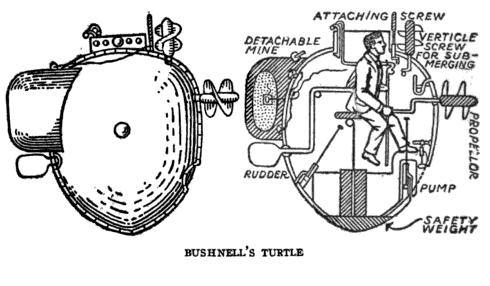
American inventor David Bushnell created the world’s first submersible with a documented record of use in combat. Her contraption was a wooden vessel moved by manned Archimede’s screw, or more likely as suggest reports, paddle propeller blade, which was to operate submerged, by night, moving towards the hull of an enemy ship and depositing a powder charge right on the hull to detonate later.
His first attempt against Admiral Richard Howe’s flagship, Eagle in 1776 failed. In October 5 he attempted to blast a Frigate but was spotted and sunk. Bushnell survived to attempt two other attacks, this time on HMS Cerberus. Washington called the attempt “an effort of genius”, but the man behind the invention, perhaps inspired by works from Denis Papin and others died in obscurity. He still is considered as the father of submarine warfare. His attempt inspired Fulton to work on underwater submarines, but despite the arrival of steam as a possible power source, no more known attempts had been made, at least for 90 years.
Confederate CSS David and HL Hunley, 1861-62

The blocus imposed to a weak Confederate Navy that had to make due with commerce raiders and river monitors (included soon, the revolutionary Merrimack), imposed some innovative solutions to disrupt this blocus by sinking some Union ships. One of these daring attempts was the CSS David.
Although strictly speaking she was not a submarine, but a submerged spar-torpedo vessel. The idea behind is less related to concealment (the CSS David was a steamship, and therefore had a conspicuous coal smoking funnel) than protection against fire. Water indeed acted as a buffer for projectiles.
It was already what saved many GIs forced to jump overboard on the beaches of Normandy in June 1944, and these were MG.34 bullets, which had very high initial velocity. Against the lead balls and spherical bombs used at that time fired by very low-velocity mouth-loading bronze or iron guns, there were little chances to hit (but a lucky one) such a submerged ship.
The idea resurfaced in the 1860-70s in Europe with several classes of iron sea-going ships having such capabilities, like the British HMS Polyphemus. In any case, the CSS David (or the Manassas for that latter) was a brave attempt that ultimately failed. More on this matter.
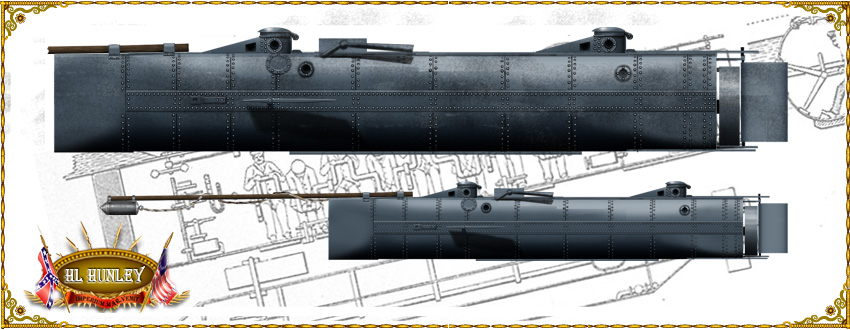
On the other hand, the HL Hunley named after Horace Lawson Hunley, was designed at Mobile with John Mc Clintock, as a true submersible blockade-runner. She was a steel, cigar-shaped and human propelled cigar with a spar torpedo (a mine carried by a long spar).
This extraordinary contraption was discovered and salvaged, and showcased in TV shows in 1936 and 1999. This was not the first modern submarine, a title that could have been given to the French Plongeur, much more complex, but for the limited industrial capabilities of the South, this remains a formidable endeavour, yet only partially successful.
The HL Hunley sank twice (two times with all hands), but managed to sank nevertheless the USS Housatonic. So she registered the world’s first submarine “kill”. Again, the “torpedo” designated back then a mine carried by a spar, which role was only to get the boat far enough from the blast to not be fatally damaged herself.
The Alligator, 1862

This submarine was the first USN registered one, and related to the HL Hunley. She was at the origin a small submersible ship designed by French engineer Brutus de Villeroi to be constructed by Neafie & Lev. It was about 30 ft long, 6 ft to 8 ft in diameter, made of iron.
The upper part had small circular glass plates for natural lighting. The cigar-shaped boat also had several watertight compartments. She carried eighteen men, activating the sixteen hand-powered paddles protruding from the sides. On 3 July 1862, these were replaced by a single hand-crack propeller at the Washington Navy Yard.
Speed was improved by four knots. Air supply came from the surface by two tubes with floats, to stay level. The aor was sucked in by an air pump inside the submarine. Therefore the Alligator was the first operational submarine ever with an air purifying system.
The Alligator also had a forward airlock, for a diver to leave and return to the vessel while submerged. This was to allow a diver to affix on an enemy ship’s hull a mine, return and detonate the charge by connecting the mine’s insulated copper wire to a battery inside the sub.
It sound odd that the US Navy world want such a weak-to-strong type of vessel given its numerical superiority. but the Alligator was design to counter the new Confederate wooden-hulled blockaders like the Merrimack then in construction according to intelligence reports.
Completion delays were therefore limited to 40 days: The keel was laid just after the contract was signed, on 1 November 1861, but the concept was so new that 180 days passed before the launch, on 1 May 1862. After a few sorties, the Alligator was foundered on April 1863, following a storm. By all standards it was the first US Navy submarine.
Lake vs Holland: Founding fathers
The last of the secession war submarine model was the “Intelligent whale” of which a photo had survived. It was born from a group of Northern speculator, creating the American Submarine Company in the hope the U. S. Congress would approve the use of privateers.
But since it was not to be, construction of first company product, the “Intelligent Whale” dragged on. It was not completed until… 1866. O. S. Halstead persisted in trying to sell the concept for years to the government, and ultimately the U.S. Navy accepted to test it in 1872.
But the submarine uttery failed and later Halstead was murdered for personal reasons.
Without the urge of wartime, submarine innovation went back to Europe. Already at the time the USS Alligator was in service, the French Plongeur was constructed. It was the first submarine not relying on human power for propulsion, using compressed air as a propellant.
In 1864 Ictineo II, designed by Monturiol made its debuts. After the invention and development of the torpedo by Whitehead, in 1878 the British Resurgam was also built. Soon another model, the Nordenfelt appeared. In the 1880s, electrical power was promising and a flurry of prototypes appeared, in Russia (Drzewiecki models), France (Dupuy de Lôme and Gustave Zédé), England (Ash and Campbell’s Nautilus), Spain (Isaac Peral)…
It would take until the 1890s and newborn naval ambitions before the Spanish-American war for interest was renewed in submarines. The two great pioneers in that matter were personalities such as Simon Lake and John Holland (“a Quaker and an Irish nationalist”).
Simon Lake:
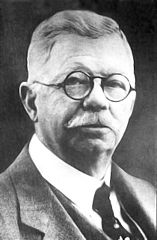 A Quaker born September 4, 1866, he was a gifted mechanical engineer and naval architect, securing over time about 200 patents. He built his first submarine, the Argonaut Junior in 1894.
A Quaker born September 4, 1866, he was a gifted mechanical engineer and naval architect, securing over time about 200 patents. He built his first submarine, the Argonaut Junior in 1894.
It was in response to the 1893 US Navy requirement for a “submarine torpedo boat”. In 1898 he made the larger Argonaut 1, sailing abour 1000 yards from Norfolk to Sandy Hook in New Jersey but spotted many problems and rebuilt it into a much larger 36 to 60-foot Argonaut 2. He also built the Protector in 1901, the first with diving planes and flat keel. However none of his designs were accepted by the Navy. Level diving was to be howeber a key feature in early American submarines.
The Protector also patented a lock-out chamber for divers. However not being a shrewd businessman like Holland, Lake did not had the resources to continue his work in the United States. Instead he sold his design to Imperial Russia in 1904. They built the Osetr and later Kaiman out of it. Lake also worked seven more years in Europe, this time for the Austro-Hungarian Navy and Kaiserliche Marine. He returned to Milford and died there in 1945, having funded ultimately the Lake Torpedo Boat Company in Bridgeport, Connecticut, which delivered 26 submarines including the USS G-1, setting the world depth record at 256 feet (78 metres) in November 1912. His first model after the protector was the Defender.
But he had to cease activities in 1922 and tried later himself to maritime salvage systems, Arctic exploration and acted as a USN technical advisor on submarine technology and maritime salvage during the other war.
John Holland:
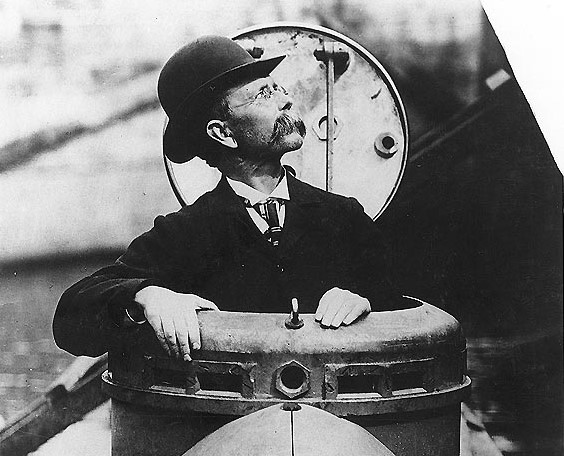
The second great innovator and pioneer in submarines was also the largest provider of the USN after when WW1 broke out, but also a successful exporter. His type became the second most popular type, adpted by the Royal Navy, Japanese Navy, and also built for the Russian Imperial Navy.
Competition was fierce in 1910, between his fellow competitor, Lake, and in Europe D’Ecquevilley, Laubeuf or Laurenti. John Philip Holland (born in Liscannor, County Clare, Ireland, 1841) taught mathematics and later emigrated in the United States in 1873.
Having learned about the battle between the ironclads Monitor and Merrimack during the American Civil War, he drew an early prototype designed to attack a ship below the waterline, proposed and rejected by the Royal Navy.
He later submitted other designs in 1875 to the USN that studied them but decided they were unworkable. The Fenians (Irish activists) however funded Holland to continue his R&D to such a point he was able to drop his teaching job and concentrate on building a prototype.
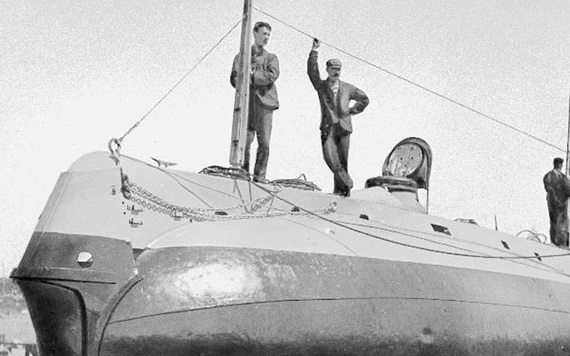
His first prototype was ready by 17 May 1897. It had sufficient power to run submerged with a great autonomy for the time and combine electric motors when submerged while gasoline engines took over in surface.
Purchased by the US Navy in April 1900, she passed all her tests high, be commissioned on 12 October 1900. By default, she was called “USS Holland”.
The Navy was so happy with the boat that six more were ordered, built at the Crescent Shipyard (Elizabeth, New Jersey). Holland however started work on his own enterprise, Electric Boat Company. Founded on 7 February 1899 with Isaac Leopold Rice acting as first President, it proceeded to built many other submarines, and will evolved in time to be merged into General Dynamics.
The USS Holland was a breakthrough in submarine design. It was adopted by the Royal Navy (Holland-class), Imperial Japanese Navy. Soon, as capacities of Electric Boat did not suffice, Fore River Ship and Engine Company in Quincy, Massachusetts took over some of the constructions.
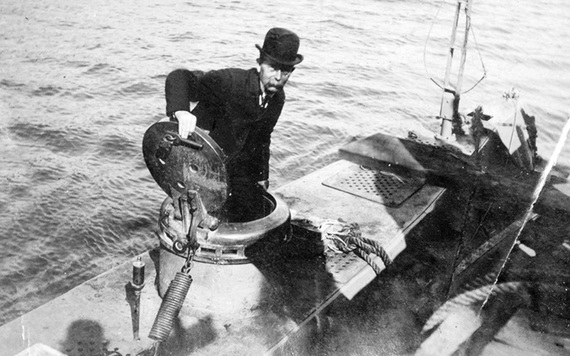
John P Holland emerging from his first submarine
In order, submarines built by Holland were the Holland I (small, unarmed, now at the Paterson Museum), the Holland II “Fenian Ram” made for, and financed by Irish revolutionaries, the Holland III was a smaller “Fenian Ram” for tests, the Holland IV “Zalinski Boat”, US Army prototype, the Holland V Plunger Prototype to showcase naval warfare in 1897, used and tested by the US Navy.
And the Holland VI (USS Holland) of the USN (1897) commissioned in 1900 and tested as a preserie. From there, Lake and Holland types would alternate until the end of the war.
Prewar American submarines (1900-1917)
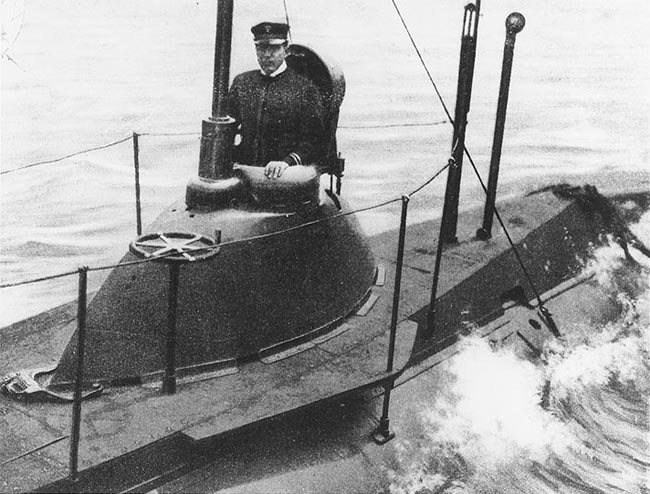
Lake would have less submarines commissioned than Holland, for sure. The USN did trust the perhaps simpler and performing Holland design, but this also went with peculiarities that were proper to American submarines:
Indeed to increase their underwater speed Holland boats introduced from the start a small sail and rotating cap over the torpedo tube muzzles plus in surface, temporary piping-and-canvas structure. The latter was long to dismantle and not helpful for crash dives so it was trashed during the war.
The system was repeated for all other Holland-type subs until the type N as a standard (1917). The war shown this system was inadequate in the North Atlantic gales and the E through L class had their bridge structures augmented with a front “chariot” shield. The N class had a well studied North Atlantic type bridge for surface operations in all weather.
The streamlined rotating torpedo tube muzzle caps cut the drag holes would cause. This was a standard until the K class, which introduced shutters. The prototype before the A-class was named Fulton, later sold to Russia as “Som”.
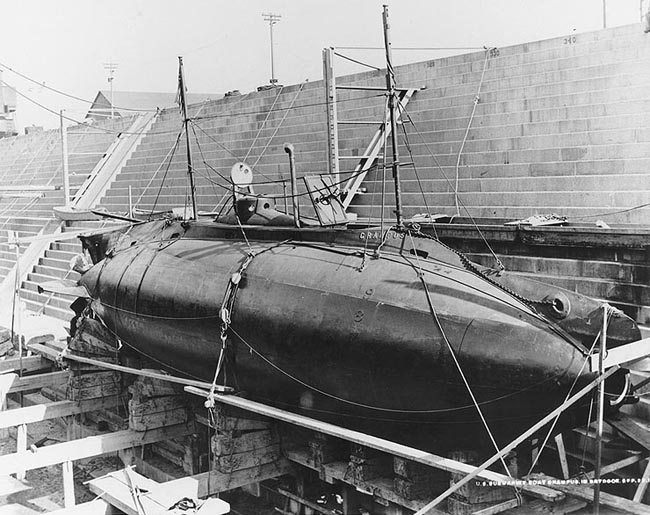
USS Grampus (A3, SS-3 1920)
The A Series (USS Plunger class) (1900)
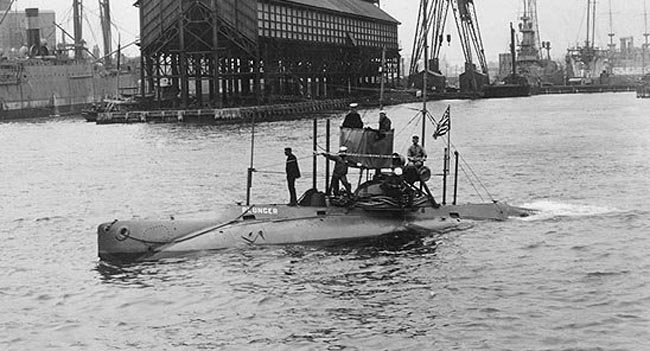
The USS Plunger was the first boat of a “class” of six USN submarines designed by Holland. The term of “class” was abusive since they all differed in many aspects. Some Historians also calls it the Adder-class as USS Adder was the first completed. However the serie was from two coasts Crescent Shipyard in Elizabethport, New Jersey and Union Iron Works in San Francisco, California.
As an experimental preserie they were used for training and testing purposes and to familiarize naval personnel with submarines for the first time in the USN. They had been renamed to A-type designation (1-7) by November 1911. The east coast squadron (five boats), remained at New Suffolk until 1905 and then was moved to Newport, Rhode Island.
After this early learning period they were all (except Plunger) shipped on colliers to the Philippines prior to the war. 17 July 1920 they became the SS-2 and following. All but the Plunger (preserved) were scrapped in 1922.
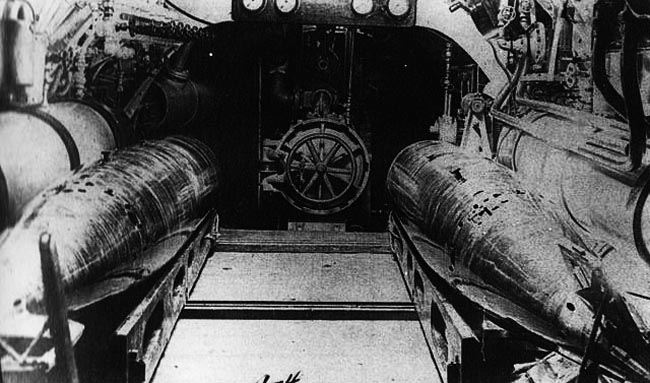
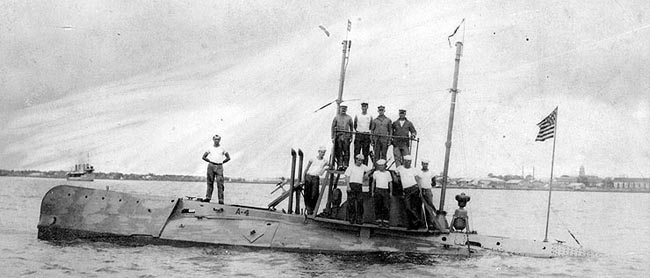
Top: USS A4 torpedo chamber, showing the single tube and two torpedoes on each side. Two “long” or three “short” 18 inch (450 mm) could be carried.
Specs (USS Plunger):
> 107 tons (sub), 19.46 m x 3.63 m x 3.23 m
> Propulsion: Otto gas. engine 160 bhp (120 kW), Electro Dynamic electric mot. 150 bhp (110 kW), 60-cell battery, 1 shaft
> Performances: 8 knots (15 km/h; 9.2 mph) surf/7 knots (13 km/h; 8.1 mph) sub. tested depth 150 ft (46 m)C
> Crew 7, Armed with a single 18 in (450 mm) TT (3 long torpedoes).
The B series (1906)
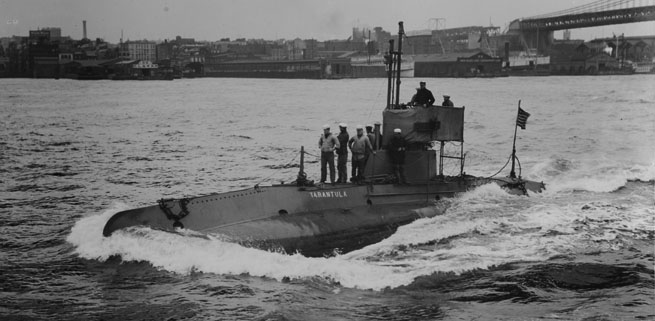
These three Holland-type boats were built by the Fore River Shipbuilding Company, Quincy, Mass. (Electric Boat Company subcontractor). The were commissioned in october and December 1907, served on the Atlantic fleet but were ultimately stationed in the Philippines in 1912. For that, they were shipped on colliers and remained there until 1915. Originally they were called Viper, Tarantula and Cuttlefish, and were decommissioned in 1919, 1921, scrapped shortly after.
Specs:
> 145/173 long tons surface/submerged, 25.15 x 3.81 x 3.20 m
> Propulsion: Craig Shipbuilding Co. gas. engine, 250 bhp (190 kW), Electro Dynamic electric mot. 150 bhp (110 kW), 60-cell battery, 1 shaft
> Performances: 9/4 knots surface/submerged 540 nautical miles (1,000 km; 620 mi) (12 sub) tested depth 150 ft
> Crew 7, Armed with 2 x 18 in (450 mm) TT (4 torpedoes).
The C series (1908)
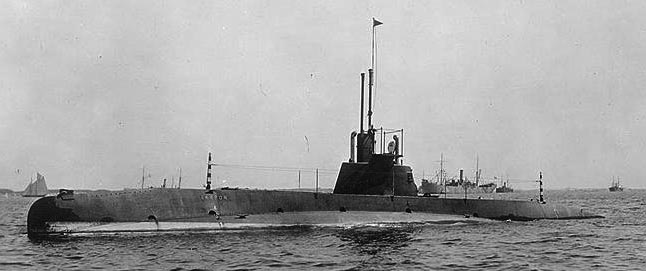
The Holland-type C-class submarines were five boats built by the Fore River Shipbuilding Company in Quincy, Massachusetts, a subcontractor of the Electric Boat Company, between 1906 and 1909, commissioned in 1908. Larger than the B-class they displaced 275 tons submerged plus used two-shaft propulsion for the first time.
They served in the Atlantic Fleet (Norfolk) and by May 1913, sailed to Guantanamo Bay, Cuba. They trained off cuba until December and later sailed for Cristóbal, Panama Canal. This 700-mile (1,100 km) cruise was the longest on record for American subs. They remained there as a local defense unit during WW1, at Coco Solo base until decommission in 1919.

Conway’s profile of the C-class submarines
Specs:
> 238/275 long tons surface/submerged, 325.11 x 4.24 x 3.0 m
> Propulsion: 2x Craig Shipbuilding Co. gas. engine, 50 bhp (190 kW) and Electro Dynamic electric mot. 300 bhp (110 kW), 60-cell battery, 2 shafts
> Performances: 10.5/9 knots surface/submerged 800 nautical miles (1,500 km; 920 mi) (80 sub) tested depth 200 ft
> Crew 15, Armed with 2 x 18 in (457 mm) bow TT (4 torpedoes).
The D series (1909)

These three submarines made by Electric Boat (design) at Fore River Shipbuilding, Quincy, Massachusetts and designed by Holland. They were basically enlarged versions C-class, and first with four torpedo tubes (bow, no reloads). 134 feet 10 inches (41.1 m) long by 13 feet 10 inches (4.2 m) for 288 long tons (293 t) at the surface and 337 long tons (342 t) submerged they comprised a crew of 14 and could dive at 200 feet (61.0 m).
For surface power, they had two 300 hp (224 kW) NELSECO gasoline engines and submerged, two 130 hp (97 kW) electric motors, with twice 60-cell batteries. With 13 knots (24 km/h; 15 mph). They showed a toop speed indeed barely able to compete even with pre-dreadnought battleships. But their range was 1,179 nautical miles (2,184 km) and underwater they can run at 9.5 knots. During the war they served for training on the US East Coast, and were all sold for scrap in 1922.

Conway’s profile of the D-class submarines
Specs:
> 288/337 long tons surface/submerged, 41.10 x 4.24 x 3.81 m
> Propulsion: 2x gas. engines, 600 bhp (450 kW) Electro Dynamic electric mot. 330 bhp (250 kW), 60-cell battery, 2 shafts
> Performances: 13/9.5 knots surface/submerged 1,780 nautical miles (2,185 km; 1,357 mi) (24 sub) tested depth 200 ft
> Crew 15, Armed with 4 x 18 in (457 mm) bow TT (4 torpedoes).
The E series (1911)
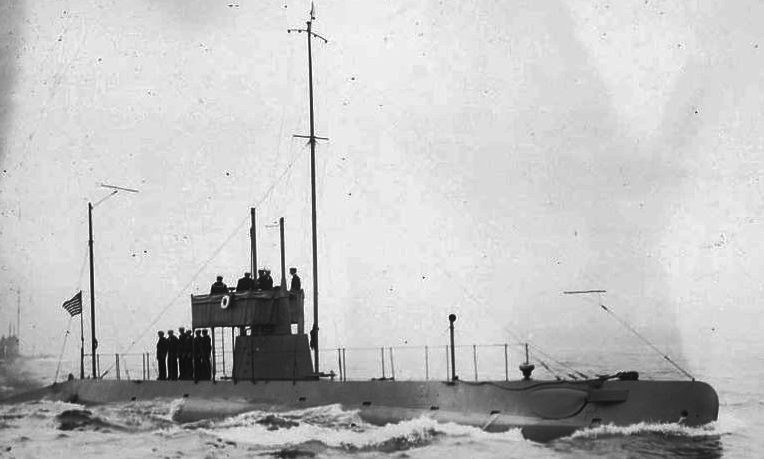
These only two boats made by Fore River Shipbuilding, designed by Holland, displaced 340 tons, like the preceding D class. but they were the first US diesel-powered submarine.
Their engines however were replaced in 1915. They also introduced a cook in the galley and bow planes. Nicknamed “pig boats” due to mediocre living quarters and strange hull shape, they tested and evaluated tactics and equipment. E-1 was posted in to the Azores on wartime and the other kept at home, scrapped in 1922.
Specs:
> 287/342 long tons surface/submerged, 41.22 x 4.45 x 3.56 m
> Propulsion: 2x Nelesco diesels, 700 bhp (522 kW) Electro Dynamic electric mot. 600 bhp (447 kW), 120-cell battery, 2 shafts
> Performances: 13.5/11.5 knots surface/submerged 2,100 nautical miles (3,900 km) (100 sub at 5 knots) tested depth 200 ft (61 m)
> Crew 20, Armed with 4 x 18 in (457 mm) bow TT (4 torpedoes).
The F series (1911)
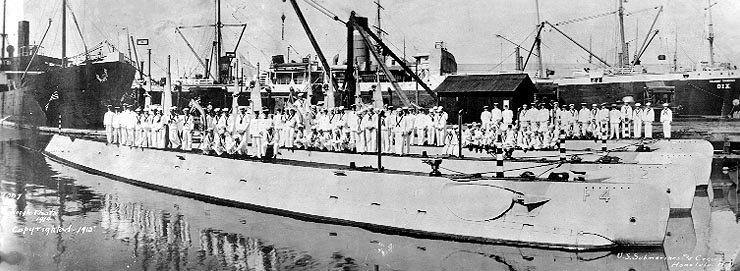
Made by Holland’s Electric Boat in 1909, the F-1 and F-2 were from Union Iron Works (San Francisco) and the two others were from Moran Bros (Seattle, Washington). They were similar to the C-Type/D-class but larger at 400 tons (submerged), single-hull, 142 feet 6 inches (43.43 m) in length.
The E and F-classes innovated by having bow planes. but their early diesels were troublesome and replaced in 1915. The front torpedo room countain four 18 inch torpedo tubes, control room (ballast, hydroplane, periscope) in the middle, and the engine room compartment at the rear with the two diesels.
The latter were clutched to shafts turning electric motors/generators for batteries. The submarine’s battery comprised cells in rubber-lined, open-topped, steel jars. All four served in the Pacific Fleet (San Pedro, Los Angeles) or Hawaii. The F-4 was lost off Hawaii on 25 March 1915 (battery acid leak) while F-1 and F-3 collided and the first sank as a result. The two survivors were scrapped in 1922.

Conway’s profile of the F-class submarines
Specs:
> 330/400 long tons surface/submerged, 43.5 x 4.7 x 3.7 m
> Propulsion: 2x Nelesco diesels 780 bhp (582 kW) & Electro Dynamic electric mot. 620 bhp (462 kW), 2x 60-cell battery, 2 shafts
> Performances: 13.5/11.5 knots surface/submerged 2,300 nautical miles (4,300 km) (10 sub) tested depth 200 ft
> Crew 22, Armed with 4 x 18 in (457 mm) bow TT (4 torpedoes).
The Lake G series (1912)

These Lake type boats were a class of four early USN submarines. They worked a bit as a preserie, and differed by many points, to the point of only artificially stick to the same class. The result from a competition in submarine design, the G-1 (built by Newport News) and G-2/G-3 (New York Navy Yard) were designed by Simon Lake while G-4 (Cramp) was designed by American Laurenti with its typical double hull system.
These boats were the last gasoline-powered. The G-1 was a private venture intended for the USN, fitted with three sets of diving planes amidships, not to the bow. It was thought to be a safer design than the angle type. She had six 18 inch (450 mm) torpedo tubes (two in the bow, four in twin trainable upper mounts firing abeam). During the war, as G-2, whe was fitted with “chariot” bridge shields to improve their surface performances.
G-2 had four 18-inch torpedo tubes, alternating internal and external, bow and stern (an innovation), with 8 torpedoes in reserve. After drawing four engines in tandem it was later decided to fit only two.
G-3 had six 18-inch torpedo tubes with two stern external tubes and 10 torpedoes in reserve and tested diesel engines. She also had sponsons to improve stability. G-4 had 8 torpedoes and a mix of external, internal bow and stern tues. She also had four engines in tandem as in G-2 without clutch between them and was plagued by severe vibrations.

G1 in 1912
During the war, the G1 (Com. 1912) served mainly for tests and training and was decommissioned in March 1920 redesignated SS-20 and later sunk as a target. G-2 (Tuna) launched in January 1912 and commissioned in December 1913 for tests, fully in February 1915 was decommissioned in 1919 and sunk as a target. G-3 (Turbot) was only commissioned in March 1915, and served for training and patrols. She was decommissioned and scrapped in 1922. G-4 was commissioned in January 1914, decommissioned in 1919 and scrapped in 1921.
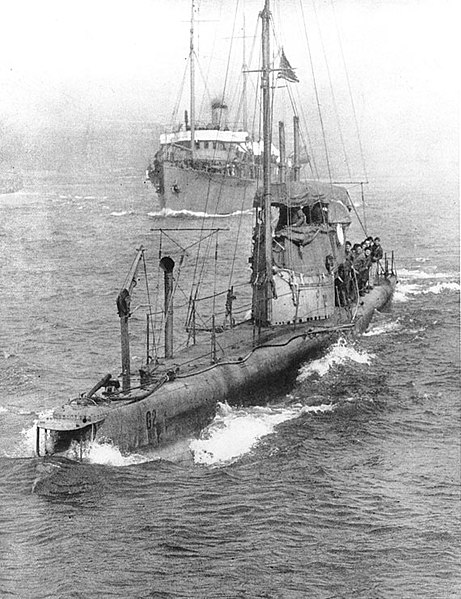
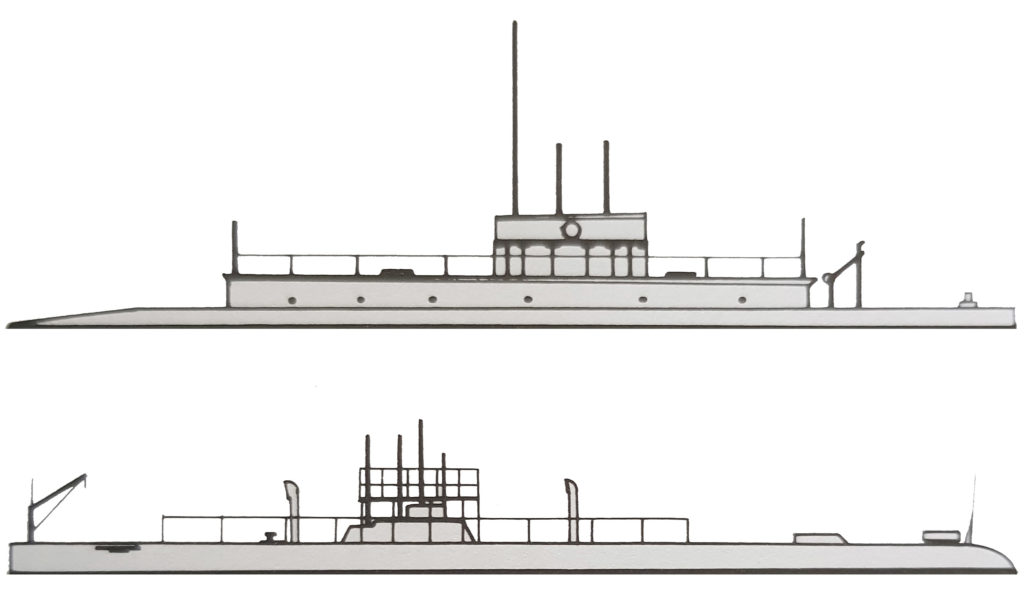
Conway’s profile of the G-class submarines, Lake group boats on top
Specs:
> 360-400/457-516 long tons surface/submerged, 48-49 x 4-5.2 x 3.4-3.7 m
> Propulsion: Gas./Diesel, see notes, 2 shafts
> Performances: 14/8.5-10 knots surface/submerged 2,500 nautical miles (4,600 km) (70 sub at 5 knots) tested depth 200 ft (61 m)
> Crew 24-26, Armed with 4/6 x 18 in (457 mm) bow TT (6-10 torpedoes).
The H series (1911)

USS H1
It was the first large scale serie of American submarines, and the first three earlier, as a preserie. These were launched in March–April 1911, named Seawolf, Nautilus and Garfish (later H-class), and commissioned in December 1913 to January 1914. However the twist in this story was that in 1915 a desperate Imperial Russian Navy for more subs ordered no less than 17 H-class from the Electric Boat Company.
However to go around strict neutrality policies of the US Government, they were built in Canada, at a shipyard near setup near Barnet, Vancouver, in British Columbia. Eleven were delivered, but for the next series construction was suspended as the Russian revolution of 1917 erupted and later prevented all deliveries.
So they were stored in knockdown conditions until purchased by the USN on 20 May 1918, assembled at Puget Sound Navy Yard. They were commissioned as the war was drawing to an end and saw little service, decommissioned in 1922, stricken in 1930, and sold for scrap in 1931-1933. Technically, they were close to the G-type, faster submerged, all diesel-equipped but with slighter less range.
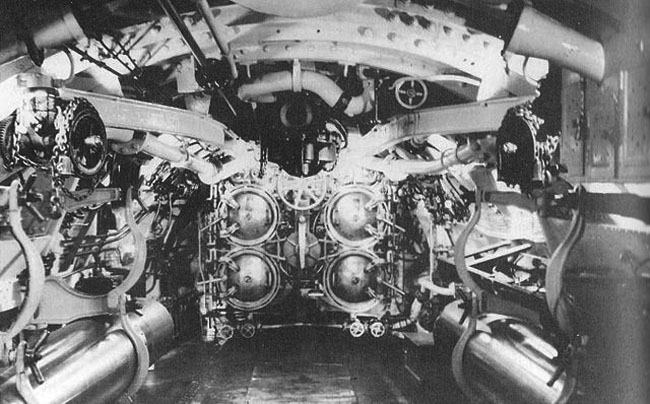
USS H5 torpedo room

Conway’s profile of the H-class submarines
Specs:
> 358/467 long tons surface/submerged, 45.8 x 4.8 x 3.8 m
> Propulsion: 2 Nelesco Diesel 950 hp, 2 electric motors 600 hp, 2 shafts
> Performances: 14/10.5 knots surface/submerged 2,300 nautical miles (4,300 km) (100 sub at 5 knots) tested depth 200 ft (61 m)
> Crew 25, Armed with 4 x 18 in (457 mm) bow TT (8 torpedoes).
Wartime American submarines
The K series (1914)
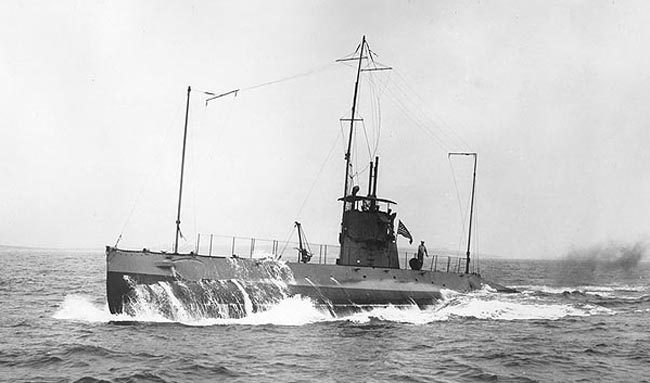
These eight boats designed by Electric Boat and built several subcontractors yards served from 1914 to 1923. K-1-2, and K-5-6 were from Fore River Shipyard in Quincy and K-3, K-7, K-8 by Union Iron Works while K-4 came from Seattle Construction and Drydock Company. Generally similar to the H class, they were larger and started their careers on the US East Coast.
During WW1 they were deployed to the Azores as convoy escorts. Many kessons were learnt of operations in rough weather. Four were stationed on the West Coast, then moved to Key West, Florida for training and patrols in 1918. They were all scrapped after decommission in 1922 to comply with Washington treaty limitations.
Specs:
> 392/521 long tons surface/submerged, 46.9 x 5.1 x 4 m
> Propulsion: 2 Nelesco Diesels 950 hp, 2 electric motors 680 hp, 2 shafts
> Performances: 14/10.5 knots surface/submerged 4,500 nautical miles (8,800? km) (100? sub at 5 knots) tested depth 200 ft (61 m)
> Crew 28, Armed with 4 x 18 in (457 mm) bow TT (8 torpedoes).
The L series (1914)
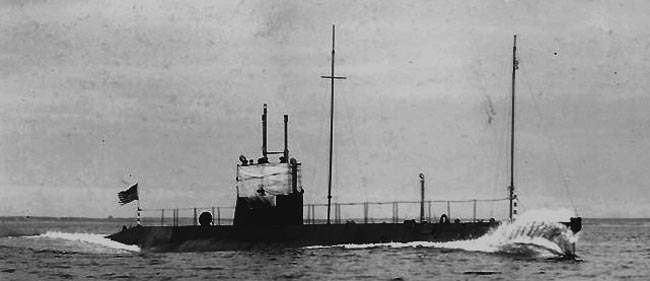
The L-class were 11 boats built from 1914 to 1917, and first USN ocean-going submarines. The Group 2 were designed by Lake (L-5-8) differing from the Holland type Group 1. Some authors even make it a separate separate L-5. They were fitted by the usual small sail, temporary piping-and-canvas structure and during wartime these were eliminated while their bridge structures received a front “chariot” shield.
This was also the first class to swap their usual torpedo tubes rotating caps by conventional shutters. The L clas was also the first to use a deck gun, a standard 3-inch/23 caliber (76 mm), partially retractable into the deck, vertically, with a round shield that fits in a well of the superstructure. The L-9 introduced it at construction while the others received it later. The barrel protruded from the deck.
These boats served with the Atlantic Flotilla (Holland’s Group 1 boats) but were extensively refitted for service at Philadelphia yard in 1917. In December these seven group 1 boats went to Bantry Bay, submarine Division 5 (Subdiv 5) for convoy escort and ASW patrols. Group 2 boats sailed to the Azores in November 1918 (Subdiv 6), displaying “AL” pennant numbers as t not be taken for British L-class submarines.
No L-class won any significant victory. They were considered under-powered, but can patrol for long in their North Atlantic/British isles area of operation. After 1918 they tested new torpedoes with new hydrophone equipment and were decommissioned in 1922 and 1923. Three apparently had Busch-Sulzer diesels. The four Group 2 (Lake boats) were scrapped in 1925.

Conway’s profile of the L-class submarines
Specs:
> 450/548 long tons surface/submerged, 51 x 5.3 x 4.1 m
> Propulsion: 2 Nelesco Diesel 1200 bhp, 2 electric motors 800 bhp, 2 shafts
> Performances: 14/10.5 knots surface/submerged 3,300 nautical miles (5,500 km) (150 sub at 5 knots) tested depth 200 ft (61 m)
> Crew 28, Armed with 4 x 18 in (457 mm) bow TT (8 torpedoes) and 1x 3in/23 gun.
USS M1 (1914)
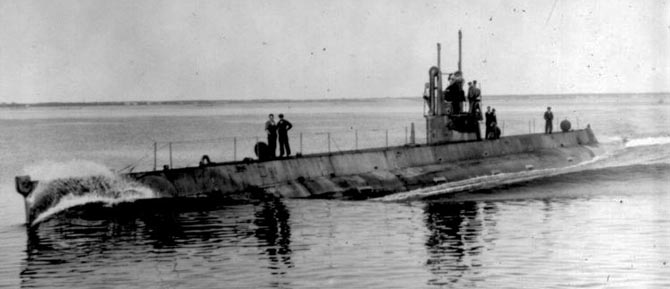
The M-1 was a prototype designed to test new construction and design recipes. She was the first double-hulled design, a new, safer battery was tested and lessons learned were incorporated into the following AA/T classes. She also had the same armament, and range as the L class, but was significantly wider due to the double hull design.
This solution was found safer for the crew, and provide additional reserve buoyancy. The was also a provision for a retractable 3 in (76 mm)/23 cal. deck gun tested on this prototype for a future incoporation in later models. Laid down in July 1914 at Fore River Shipbuilding Company she was launched in September 1915 and commissioned in February 1918.
She served with the Submarine Division 2 at Newport, Rhode Island. She never saw active service in wartime, but patrolled the East Coast, as a training boat and later was affected to SubDiv 5 and SubDiv 3. She was evetually decommissioned at Philadelphia NyD in March 1922.
Specs:
> 488/676 long tons surface/submerged, 59.8 x 5.8 x 3.4 m
> Propulsion: 2 Nelesco Diesel 840 hp, 2 electric motors 680 hp, 2 shafts
> Performances: 14/10.5 knots surface/submerged 2,750 nautical miles ( km) (3h endurance ? sub at 5 knots) tested depth 200 ft (61 m)
> Crew 28, Armed with 4 x 18 in (457 mm) bow TT (8 torpedoes), 1x 3in/23 gun.
AA/T class (1916)
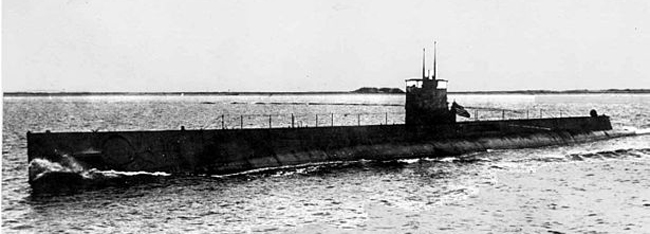
This class of submarines designed by Holland -Electric boat Cie, was created to answer USN 1914 specification for a true “fleet submarine”. The definition given was a larger and better armed boat with a surface speed of 21 knots (39 km/h; 24 mph) to sustain the pace of the new 21-knot dreadnoughts, like the Delaware class.
Chief naval architect Lawrence Y. Spear was in charge. He proposed two preliminary fleet-boat designs in 1914. The first boat was laid down in June 1916, as USS Schley. It was twice larger than any other American submarine at 1,106 tons surfaced, 1,487 tons submerged, for 270 feet (82 m) long.
However this large size weakened her structural rigidity and operational depht to 150 ft (46 m). Power was gargantuan compared to previous submarine to achieve the designed speed: Two tandem 1,000 horsepower (750 kW) diesel engines and a third one to load the batteries. Two sister-ships were authorized in 1915, to be named later AA-2 and 3 and later T2-3.
If they made their design speed of 20 knots (37 km/h; 23 mph), external torsional vibration and were clutch problems made them troublesome and it was found impossible to synchronize their operation. These engines were New London Ship and Engine Company (NELSECO) four-cycle six-cylinder diesels (500 hp x2).

Conway’s profile of the AA/T-class submarines
They were coupled with two Electro Dynamic main electric motors 675 hp (503 kW) each while the batteries had 60-cells of the Exide type. There was also the auxiliary NELSECO four-cycle four-cylinder diesel generator for the batteries. This made for a complicated and crowded machine compartment.
T3 from 1923, until 1927 tested two German MAN four-cycle ten-cylinder diesels rated for 2,350 hp (1,750 kW) each. They also had four bow 18 inch (457 mm) but also two single trainable external torpedo tubes in the superstructure plus two 3-inch (76 mm)/23 caliber retractable deck guns, each side of the sail. Some also tested a larger caliber (used on german sub cruisers) such as the 150 mm (5.9 inch). All three boats was based at Hampton Roads, Virginia, SubDiv 15, Atlantic Fleet.
In 1920 they were renamed SF-1, SF-2, and SF-3 (fleet boats) and decommissioned by 1923, stored at Philadelphia, Pennsylvania. Only T3 was reactivated to test German diesels. All three were sold for scrap on 20 November 1930, not considered successful as they can’t reach their designed speed of 21 knots or dive deep enough for safety.
Specs:
> 1107/1482 long tons surface/submerged, 82 x 7 x 4.3 m
> Propulsion: 2×2 Nelesco Diesel 4000 bhp, 2 electric motors 1350 hp, 2 shafts
> Performances: 20/10.5 knots surface/submerged 3000 nautical miles (4,000 km) (100 sub at 5 knots) tested depth 150 ft (46 m)
> Crew 25, Armed with 4 x 18 in (457 mm) bow TT (8 torpedoes).
The N series (1915)

A return to standard coastal American submarines, this 400 tons class or seven boats were built in two groups, at Seattle and Lake, launched in November-December 1916 to May 1917. Tey were the first to introdue metal bridges to improve their seakeeping in surface. This was a direct gain for early war lessons with boats sent to the West Atlantic.
Power was reduced to reach better reliability, and the success of these boats in operations led to the design of follows-up like the O, P and S classes. This also lef to redesign the bridge of all recent classes for wartime service. Despite of this, Versailles treaty clauses gave the USN some U-boats, and therefore German MAN diesels were tested instead of the Nelesco models, showing quite a gap in level of power and reliability. The N5 was based in new York in 1918.
Specs:
> 348/414 long tons surface/submerged, 44.9 x 4.8 x 3.8 m (Lake boats 47.3 x 4.4 m)
> Propulsion: 2 Nelesco Diesel 600 bhp, 2 electric motors 300 hp, 2 shafts
> Performances: 13/11 knots surface/submerged 3500 nautical miles (? km) (30 sub at 5 knots) tested depth 200 ft (65 m)
> Crew 25, Armed with 4 x 18 in (457 mm) bow TT (8 torpedoes).
The O series (1916)

These submarines knew two world wars.
This late war O-class designed by Holland were built in small groups at Portsmouth NyD (O1), Puget Sound NyD (O2), Fore River (O3-10), Lake (O11-13) and California SB NyD (O14-16), a total of 16 boats, launched Nov. 1917 to May 1918. As usual Lake boats differed from the others, being 491 tons surfaced and 566 submerged, 52.4 x 5.1 x 4.2 m in size, and having BS diesels instead of the usual Nelesco models, but performances and armament were similar.
O7 was comm. in july 1918 and carried out east coast patrols, but most boats were used for training from 1928. O12 was reactivated as USS Nautilus and used from 1931 to try to reach the North Pole. O5 was sunk in 28.10.1923, O11 and O13-16 were discarded in 1931 but O12 was sold to Norway (and served in WW2).
O2-4 and O6-10 were still used as training submarines in WW2. R19 was actually lost on 20.06.1941. In terms of performances, they were faster in surface but slightly less submerged. generally considered as good sea boats. R12 was lost in the Atlantic, lost because of a torpedo practice approach off Key West with 42 souls on board. Most survivors were scrapped in 1946.

Conway’s profile of the O-class submarines
> 521/629 long tons surface/submerged, 52.5 x 5.5 x 4.4 m (Lake boats 47.3 x 4.4 m)
> Propulsion: 2 Nelesco Diesel 880 bhp, 2 electric motors 740 hp, 2 shafts
> Performances: 14/10.5 knots surface/submerged 5,500 nautical miles (? km) (? sub at 5 knots) tested depth 200 ft (65 m)
> Crew 29, Armed with 4 x 18 in (457 mm) bow TT (8 torpedoes), 1 x 3in/23.
The R series (1917)
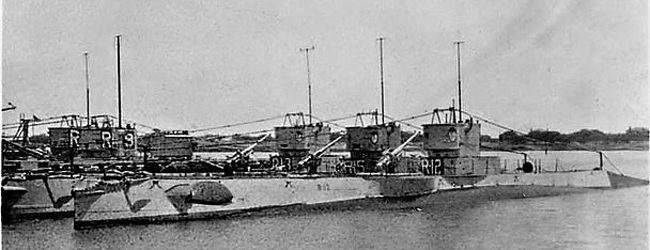
By default of having fleet submarines, the P class were “repeat-o” but with many improvements: Fruit of experience, the complication of having a partially retractable main gun was eliminated, and the new 3 in/50 mount was fixed in place.
The hull was enlarged to accomodate brand new standard fleet 21 in tubes (533 mm), with standard torpedoes which still possessed almost twice their hitting power and better speed. Surface speed was a bit better at 13.5 knots verssus 13, with the same usual 10.5 knots submerged speed. Power was greater too to compensate for the displacement increase.
Fourteen of the twenty-seven were built at Fore River Yard, subcontracted by Electric boat, R15-20 at Union Iron Works, and R21-27 at Lake. They were launched from the summer of 1918 to October 1919 so none was operational when the war ended. Part of them were discarded and scrapped in 1931 (Lake boats), but the rest were still active when WW2 broke out, kept in reserve as training boats.
One, R8, was lost in 1936. R3, R11, R17 and R19 were send to the Royal Navy through lend-lease in November 1941 and March 1942, and R11 was lost in action, sunk by error as HMS P514 in June 1943 by a minesweeper.

Conway’s profile of the R-class submarines
> 569/680 long tons surface/submerged, 56.8 x 5.5 x 4.4 m (Lake boats 47.3 x 4.4 m)
> Propulsion: 2 Nelesco Diesel 1000 bhp, 2 electric motors 800 hp, 2 shafts
> Performances: 13.5/10.5 knots surface/submerged 4,700 nautical miles (? km) (? sub at 5 knots) tested depth 200 ft (65 m)
> Crew 29, Armed with 4 x 21 in (533 mm) bow TT (8 torpedoes), 1 x 3in/50.
The S series (1918)
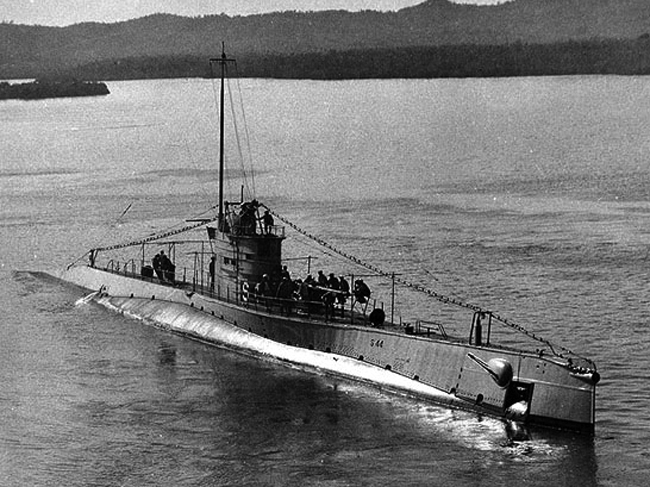
The S class would deserve special attention but since it was studied and built in stage after the war, it just is out of this topic, but will be found in the upcoming WW2 American submarines article.
The first Holland-designed class counted 41 boats, there was a single Lake prototype (S2) in 1919, 15 boats of the improved Portsmouth NyD/Lake built design, six boats of the second group built by Fore River, and four of the Lake second type. All S-class of the frst group were still active in WW2, but about half of the 2nd group.

Conway’s profile of the S-class submarines, Electric Boat type

Conway’s profile of the S-class submarines, Navy Yard type

Conway’s profile of the S-class submarines, third type
Links, read more
Other pioneers and patents at the turn of the century (last zombie island)
history.com 9-groundbreaking-early-submarines
On submarine-history.com
simonlake.com, about the submarine pioneer
John_Philip_Holland wiki
irishcentral.com – john-philip-holland
Lake_Torpedo_Boat (wiki)
usscubera.org
navy.mil/ subs
americanhistory.si.edu/ early subs
List of submarines of the USN (wiki)


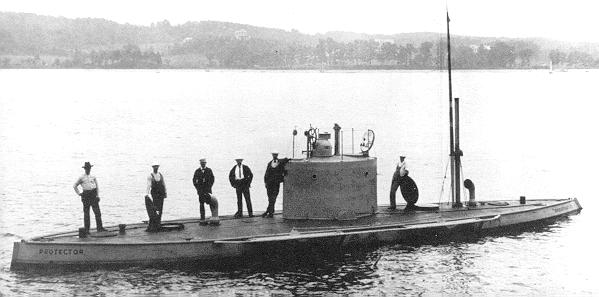
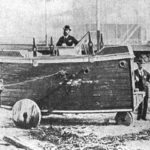
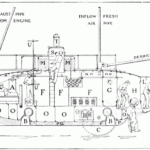
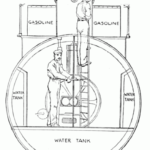
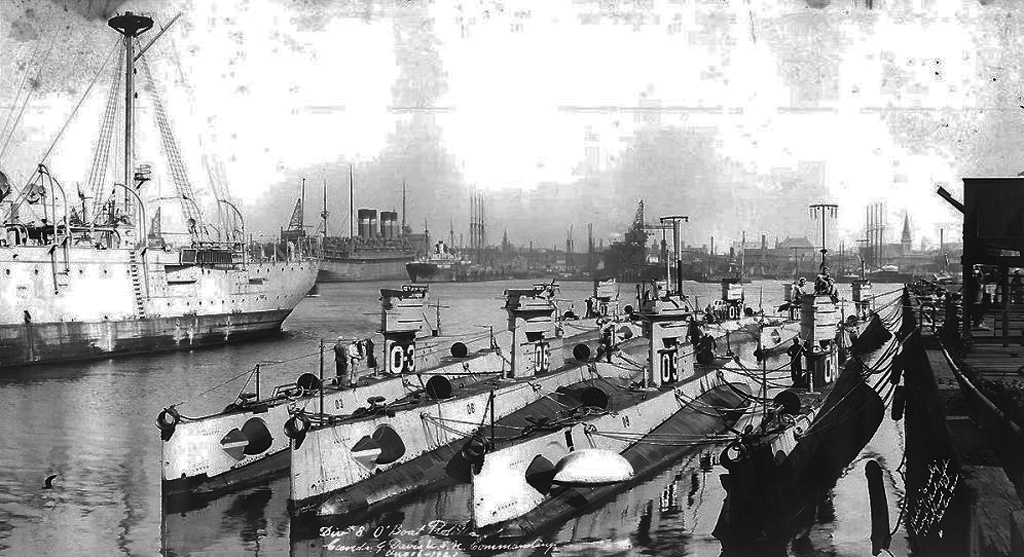
 Latest Facebook Entry -
Latest Facebook Entry -  X(Tweeter) Naval Encyclopedia's deck archive
X(Tweeter) Naval Encyclopedia's deck archive Instagram (@navalencyc)
Instagram (@navalencyc)





 French Navy
French Navy Royal Navy
Royal Navy Russian Navy
Russian Navy Armada Espanola
Armada Espanola Austrian Navy
Austrian Navy K.u.K. Kriegsmarine
K.u.K. Kriegsmarine Dansk Marine
Dansk Marine Nautiko Hellenon
Nautiko Hellenon Koninklije Marine 1870
Koninklije Marine 1870 Marinha do Brasil
Marinha do Brasil Osmanlı Donanması
Osmanlı Donanması Marina Do Peru
Marina Do Peru Marinha do Portugal
Marinha do Portugal Regia Marina 1870
Regia Marina 1870 Nihhon Kaigun 1870
Nihhon Kaigun 1870 Preußische Marine 1870
Preußische Marine 1870 Russkiy Flot 1870
Russkiy Flot 1870 Svenska marinen
Svenska marinen Søværnet
Søværnet Union Navy
Union Navy Confederate Navy
Confederate Navy Armada de Argentina
Armada de Argentina Imperial Chinese Navy
Imperial Chinese Navy Marinha do Portugal
Marinha do Portugal Mexico
Mexico Kaiserliche Marine
Kaiserliche Marine 1898 US Navy
1898 US Navy Sovietskiy Flot
Sovietskiy Flot Royal Canadian Navy
Royal Canadian Navy Royal Australian Navy
Royal Australian Navy RNZN Fleet
RNZN Fleet Chinese Navy 1937
Chinese Navy 1937 Kriegsmarine
Kriegsmarine Chilean Navy
Chilean Navy Danish Navy
Danish Navy Finnish Navy
Finnish Navy Hellenic Navy
Hellenic Navy Polish Navy
Polish Navy Romanian Navy
Romanian Navy Turkish Navy
Turkish Navy Royal Yugoslav Navy
Royal Yugoslav Navy Royal Thai Navy
Royal Thai Navy Minor Navies
Minor Navies Albania
Albania Austria
Austria Belgium
Belgium Columbia
Columbia Costa Rica
Costa Rica Cuba
Cuba Czechoslovakia
Czechoslovakia Dominican Republic
Dominican Republic Haiti
Haiti Hungary
Hungary Honduras
Honduras Estonia
Estonia Iceland
Iceland Eire
Eire Equador
Equador Iran
Iran Iraq
Iraq Latvia
Latvia Liberia
Liberia Lithuania
Lithuania Mandchukuo
Mandchukuo Morocco
Morocco Nicaragua
Nicaragua Persia
Persia San Salvador
San Salvador Sarawak
Sarawak Uruguay
Uruguay Venezuela
Venezuela Zanzibar
Zanzibar Warsaw Pact Navies
Warsaw Pact Navies Bulgaria
Bulgaria Hungary
Hungary

 Bundesmarine
Bundesmarine Dutch Navy
Dutch Navy Hellenic Navy
Hellenic Navy Marina Militare
Marina Militare Yugoslav Navy
Yugoslav Navy Chinese Navy
Chinese Navy Indian Navy
Indian Navy Indonesian Navy
Indonesian Navy JMSDF
JMSDF North Korean Navy
North Korean Navy Pakistani Navy
Pakistani Navy Philippines Navy
Philippines Navy ROKN
ROKN Rep. of Singapore Navy
Rep. of Singapore Navy Taiwanese Navy
Taiwanese Navy IDF Navy
IDF Navy Saudi Navy
Saudi Navy Royal New Zealand Navy
Royal New Zealand Navy Egyptian Navy
Egyptian Navy South African Navy
South African Navy






























 Ukrainian Navy
Ukrainian Navy dbodesign
dbodesign
A good web page for these early submarines is PigBoats.COM http://pigboats.com/
By the time that the AA class entered service, the chances of large scale fleet actions were remote, making the AA class superflous and irrelevant.